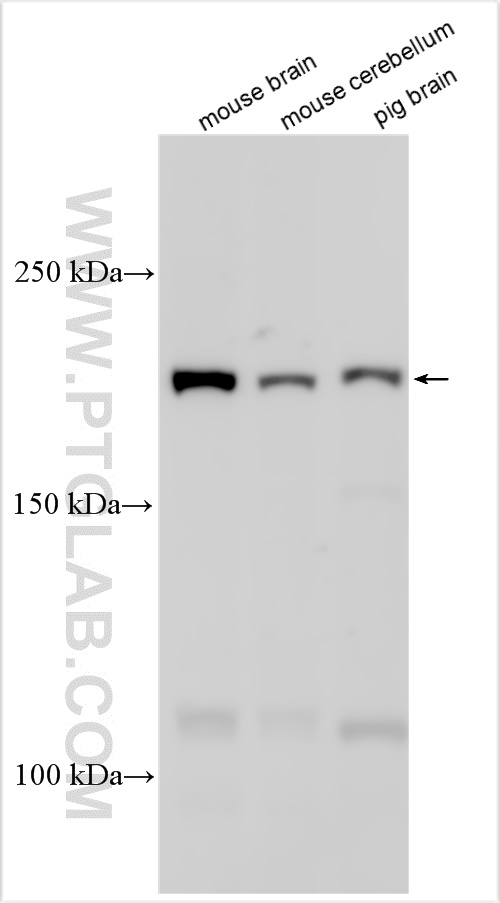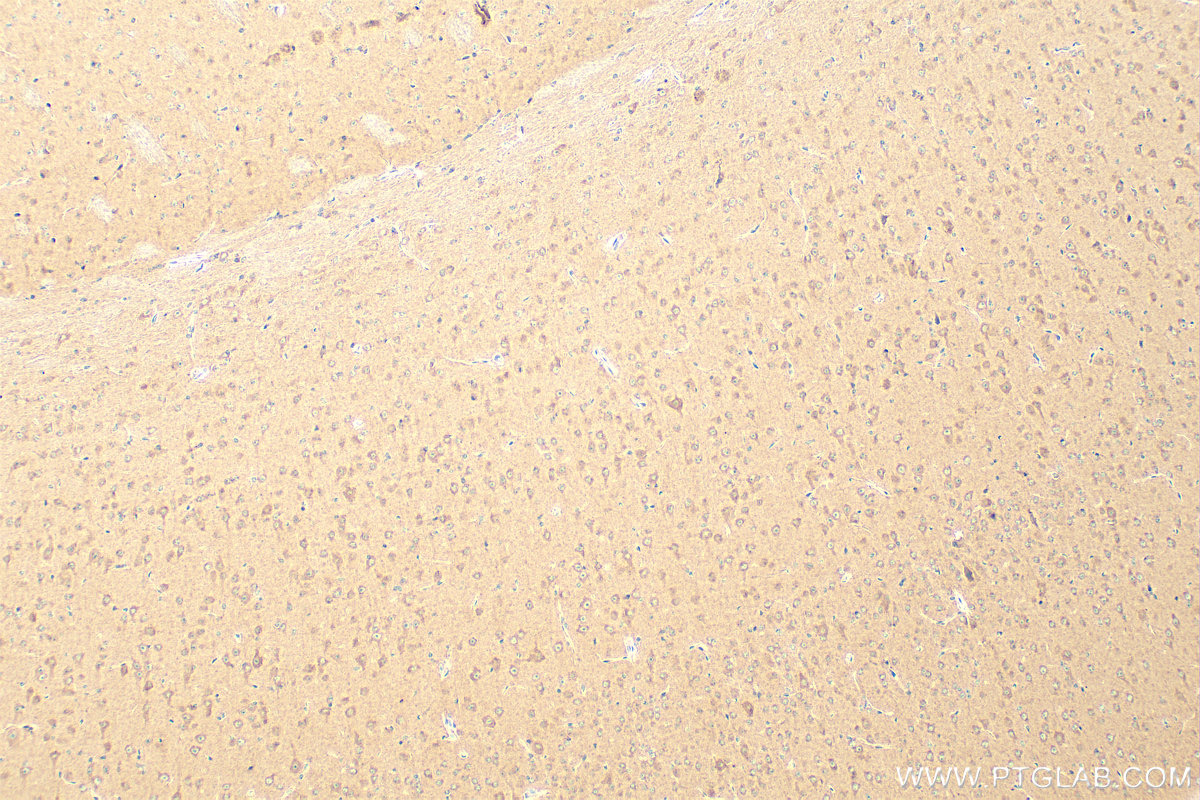验证数据展示
经过测试的应用
| Positive WB detected in | mouse brain tissue, mouse cerebellum tissue, pig brain tissue |
| Positive IHC detected in | mouse brain tissue Note: suggested antigen retrieval with TE buffer pH 9.0; (*) Alternatively, antigen retrieval may be performed with citrate buffer pH 6.0 |
推荐稀释比
| 应用 | 推荐稀释比 |
|---|---|
| Western Blot (WB) | WB : 1:500-1:1000 |
| Immunohistochemistry (IHC) | IHC : 1:50-1:500 |
| It is recommended that this reagent should be titrated in each testing system to obtain optimal results. | |
| Sample-dependent, Check data in validation data gallery. | |
发表文章中的应用
| WB | See 4 publications below |
| IF | See 5 publications below |
产品信息
20257-1-AP targets SCN9A/Nav1.7-Specific in WB, IHC, IF, ELISA applications and shows reactivity with human, mouse, pig samples.
| 经测试应用 | WB, IHC, ELISA Application Description |
| 文献引用应用 | WB, IF |
| 经测试反应性 | human, mouse, pig |
| 文献引用反应性 | mouse, rat |
| 免疫原 | Peptide 种属同源性预测 |
| 宿主/亚型 | Rabbit / IgG |
| 抗体类别 | Polyclonal |
| 产品类型 | Antibody |
| 全称 | sodium channel, voltage-gated, type IX, alpha subunit |
| 别名 | Nav1.7, SCN9A, NENA, NE NA, hNE-Na |
| 计算分子量 | 226 kDa |
| 观测分子量 | 226 kDa |
| GenBank蛋白编号 | NM_002977 |
| 基因名称 | SCN9A |
| Gene ID (NCBI) | 6335 |
| RRID | AB_11182704 |
| 偶联类型 | Unconjugated |
| 形式 | Liquid |
| 纯化方式 | Antigen affinity purification |
| UNIPROT ID | Q15858 |
| 储存缓冲液 | PBS with 0.02% sodium azide and 50% glycerol , pH 7.3 |
| 储存条件 | Store at -20°C. Stable for one year after shipment. Aliquoting is unnecessary for -20oC storage. |
背景介绍
SCN9A, also named as NENA, PN1, ETHA, NE-NA, Nav1.7 and hNE-Na, belongs to the sodium channel family. SCN9A mediates the voltage-dependent sodium ion permeability of excitable membranes. Assuming opened or closed conformations in response to the voltage difference across the membrane, SCN9A forms a sodium-selective channel through which Na+ ions may pass in accordance with their electrochemical gradient. It is a tetrodotoxin-sensitive Na+ channel isoform. SCN9a plays a role in pain mechanisms, especially in the development of inflammatory pain. Defects in SCN9A are the cause of primary erythermalgia or autosomal recessive congenital indifference to pain or paroxysmal extreme pain disorder (PEPD). The antibody is specific to SCN9A
实验方案
| Product Specific Protocols | |
|---|---|
| WB protocol for SCN9A/Nav1.7-Specific antibody 20257-1-AP | Download protocol |
| IHC protocol for SCN9A/Nav1.7-Specific antibody 20257-1-AP | Download protocol |
| Standard Protocols | |
|---|---|
| Click here to view our Standard Protocols |
发表文章
| Species | Application | Title |
|---|---|---|
Prog Neurobiol MicroRNA-96 is required to prevent allodynia by repressing voltage-gated sodium channels in spinal cord. | ||
J Neuroinflammation Glial interleukin-1β upregulates neuronal sodium channel 1.7 in trigeminal ganglion contributing to temporomandibular joint inflammatory hypernociception in rats. | ||
Inflammation Prostaglandin E2 Upregulated Trigeminal Ganglionic Sodium Channel 1.7 Involving Temporomandibular Joint Inflammatory Pain in Rats. | ||
Chin J Dent Res Non-steroidal Anti-inflammatory Drugs Attenuate Hyperalgesia and Block Upregulation of Trigeminal Ganglionic Sodium Channel 1.7 after Induction of Temporomandibular Joint Inflammation in Rats. | ||
Neurosci Lett Connexin 43 contributes to temporomandibular joint inflammation induced-hypernociception via sodium channel 1.7 in trigeminal ganglion. | ||
Front Mol Neurosci Ectopic expression of Nav1.7 in spinal dorsal horn neurons induced by NGF contributes to neuropathic pain in a mouse spinal cord injury model |


